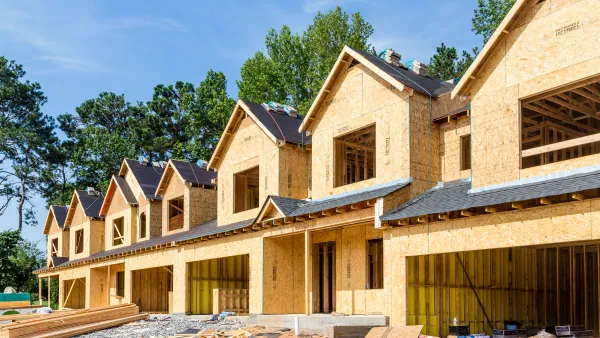Two new reports, and one older one, assign unequal significance of the ability of new market rate housing to filter older housing into affordability.

Darwin BonGraham reports: "According to a new report [pdf] by UC Berkeley researchers, the best way to prevent gentrification and displacement is to build affordable housing in cities and neighborhoods where rents and home prices are rising fastest."
"The Berkeley report is a rebuttal to an earlier, widely circulated report by the state Legislative Analyst Office [sic] that claimed the best way to prevent displacement of low-income households is to simply build more market rate housing as fast as possible," adds BondGraham. (Planetizen was one of the media outlets to circulate news of the LAO's report.)
The article includes specific details on how the new report from Berkeley researchers Miriam Zuk and Karen Chapple responds to the earlier LAO study. Among the claims made by the Berkeley study: although filtering (i.e., as new market rate units become available, older units become more affordable) does occur, the process takes longer than the LAO report acknowledges.
Just a few days after the release of the Berkeley study, the Oregon Office of Economic Analysis released the findings of an examination of filtering, writing in seeming agreement with that point. "The key is that filtering does not happen overnight. It is very much a longer run process," reads a post by Josh Lehner. However, the Oregon Office of Economic Analysis report concludes: "Filtering is also one of the major ways to provide reasonably priced workforce housing for those making in or around the median family income."
The rebuttal process also allows the Berkeley study to reach an important conclusion, as quoted directly from the study: "The development of market-rate housing may not be the most effective tool to prevent the displacement of low-income residents from their neighborhoods, nor to increase affordability at the neighborhood scale," and "to help stabilize existing communities we need to look beyond housing development alone to strategies that protect tenants and help them stay in their homes."
FULL STORY: UC Berkeley Report: Affordable Housing is Best Way to Combat Gentrifcation

National Parks Layoffs Will Cause Communities to Lose Billions
Thousands of essential park workers were laid off this week, just before the busy spring break season.

Retro-silient?: America’s First “Eco-burb,” The Woodlands Turns 50
A master-planned community north of Houston offers lessons on green infrastructure and resilient design, but falls short of its founder’s lofty affordability and walkability goals.

Delivering for America Plan Will Downgrade Mail Service in at Least 49.5 Percent of Zip Codes
Republican and Democrat lawmakers criticize the plan for its disproportionate negative impact on rural communities.

Test News Post 1
This is a summary

Test News Headline 46
Test for the image on the front page.

Balancing Bombs and Butterflies: How the National Guard Protects a Rare Species
The National Guard at Fort Indiantown Gap uses GIS technology and land management strategies to balance military training with conservation efforts, ensuring the survival of the rare eastern regal fritillary butterfly.
Urban Design for Planners 1: Software Tools
This six-course series explores essential urban design concepts using open source software and equips planners with the tools they need to participate fully in the urban design process.
Planning for Universal Design
Learn the tools for implementing Universal Design in planning regulations.
EMC Planning Group, Inc.
Planetizen
Planetizen
Mpact (formerly Rail~Volution)
Great Falls Development Authority, Inc.
HUDs Office of Policy Development and Research
NYU Wagner Graduate School of Public Service





























